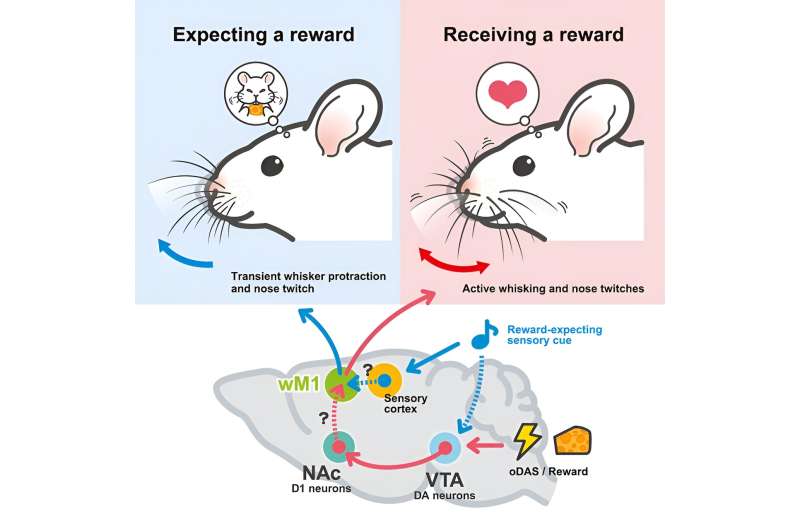This article has been reviewed according to Science X's editorial process and policies. Editors have highlighted the following attributes while ensuring the content's credibility:
fact-checked
peer-reviewed publication
proofread
Unveiling the mechanism underlying orofacial movements during reward processing in animals

In animals, movements such as locomotion or grooming are known to influence neuronal activity within the cerebral cortex. Moreover, recent studies also suggest that these changes in neuronal activity are not confined to a specific area, but are pervasive throughout cortical and subcortical regions of the brain. Interestingly, in animals trained for reward-based learning tasks, such spontaneous movements—despite being uninstructed and unnecessary—may be aligned to task events and may significantly contribute to neuronal activity during the task.
In particular, movement of orofacial parts, such as the nose and whiskers, is known to strongly correlate with brainwide neuronal activities in mice. For instance, mice that undergo stimulus-reward association training move their whiskers and exhibit orofacial movements following a reward-predicting cue. However, the underlying mechanism by which the brain generates and coordinates these "uninstructed" movements remains largely unknown.
Now, however, a team of researchers from Fujita Health University, led by Prof. Takayuki Yamashita along with co-author Wan-Ru Li of the Department of Physiology, reveals interesting insights behind these orofacial movements in mice. The study was a collaborative effort of members of the International Center for Brain Science (ICBS) at Fujita Health University, including Prof. Takayuki Yamashita, Associate Prof. Takashi Nakano, and Prof. Junichiro Yoshimoto. The study, published in the Current Biology journal on August 2, 2023, reveals the neuroscience involved in these highly characteristic orofacial movements.
To study the underlying mechanisms, the researchers first analyzed the whisker movement data of mice. While mice well trained for licking water-rewards showed rapid whisker movements immediately after reward-predicting cue presentation, the untrained, novice mice did not exhibit such movements. On examining whether these task-aligned whisker movements were specific to a task involving whisker sensation, the researchers also observed similar whisker movements even in tasks involving sound-reward associations.
Although the above tasks involve a water reward, the team further conducted experiments to induce uninstructed orofacial movements without giving a liquid reward. More specifically, the team stimulated the dopamine (DA) neurons in the ventral tegmental area (VTA)—a region in the murine midbrain that plays an important role in the motivation and reward system. The team then discovered that stimulating VTA DA neurons triggers orofacial movements.
Speaking about the results, Prof. Yamashita says, "Dopamine neurons in the VTA are very popular cells among neuroscientists who are interested in reward processing of our brain, and a lot of papers have been published on their role. But our study is the first to report that their activity can trigger orofacial movements."
Further, extensive experimentation involving machine learning revealed two distinct orofacial movements observed during reward-based learning tasks—transient orofacial actions upon reward expectation, and active, sustained orofacial movements upon receiving a reward. The study also helped elucidate the causal role of the whisker primary motor cortex (wM1)—a region in the mouse brain that plays a key role in regulating whisker movements—in triggering these motions.
"Two distinct neuronal signal flows are involved in making these two types of orofacial movements. One is the mesolimbic DA pathway, which is famous for constituting our motivational behavior. This is essential for orofacial movements upon reward acquisition. The other is a kind of bypassing pathway signaling reward-predicting cue information speedily to motor command neurons in the brain. This rapid signaling is independent of mesolimbic DA but needed to induce quick, transient orofacial actions upon reward expectation," explains Prof. Yamashita.
"Our findings reveal that these two distinct signals converge in the wM1 but elegantly drive two distinct motions," adds co-author Wan-Ru Li.
According to the researchers, this is presumably the first recorded observation of such a phenomenon and can have key clinical implications. For instance, understanding how facial movements correlate with internal states can lead to improved diagnostic and treatment strategies for mental health conditions that often involve atypical emotional responses and facial expressions.
Moreover, this newfound knowledge on differential orofacial movements in mice could lead to advancements in understanding animal emotions, and help create more compassionate and suitable environments for laboratory animals, pets, and animals in different settings like zoos or farms, ultimately enhancing animal welfare.
The researchers hope that this study serves as a milestone for animal welfare, mental health, and neuroscience research.
More information: Takayuki Yamashita, Neural mechanisms underlying uninstructed orofacial movements during reward-based learning behaviors, Current Biology (2023). DOI: 10.1016/j.cub.2023.07.013. www.cell.com/current-biology/f … 0960-9822(23)00920-X


















